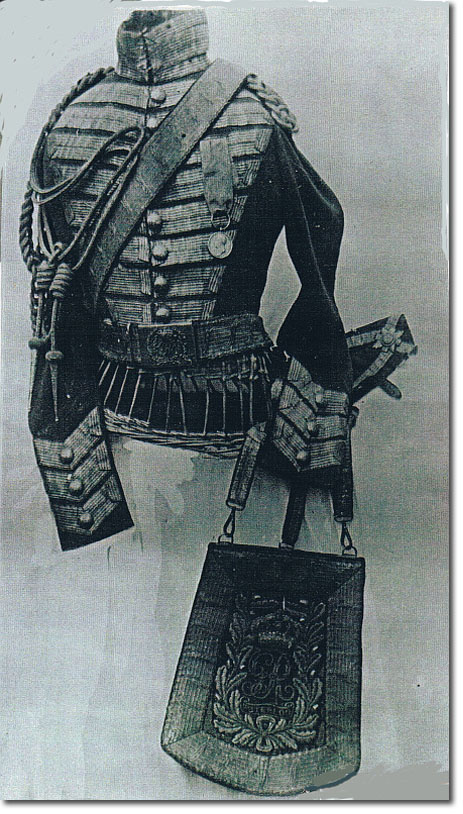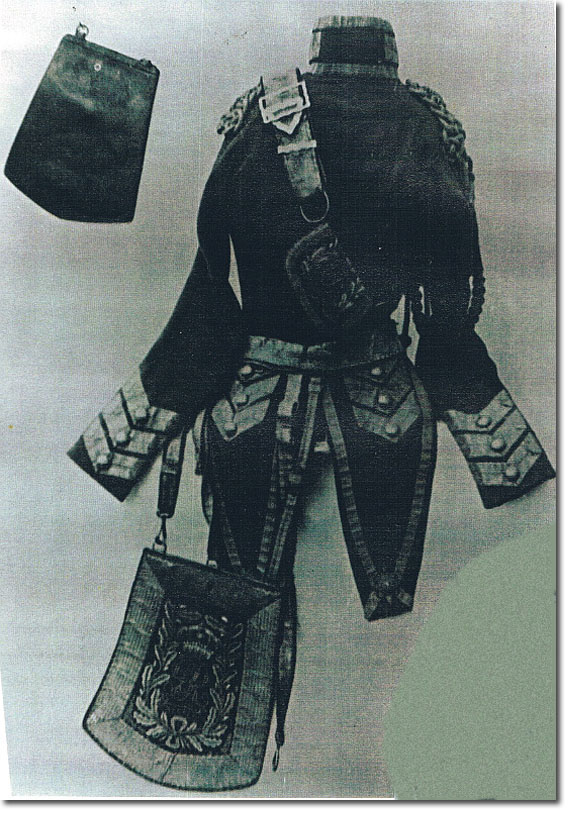|
|


|
|
This uniform belonged to Major James Wemyss who entered the Scots Greys as a cornet in 1810 and reached the rank of major on 10 June 1826. He went on half-pay on 8 Mar 1827. In the Army Historical Journal, Percy Sumner describes the coat: 'Officer's Coatee, formerly in the Cotton Museum on the Field of Waterloo. 8 Bars of gold lace, three quarter inch wide, laid double as usual (4-vellum pattern, one edge scalloped), blue collar laced all round with one loop of lace (no button), blue cuff, indented, with 3 loops and buttons, 2 buttons at the waist behind, 3 loops and buttons on skirts, blue turn-backs edged with lace, turn-back ornament a gold Star of the Order of the Thistle, gold aiguillette on right shoulder, plaited cord strap only on left, gold Garter Star on the straps.'
The poor quality photo does not show the gold star on the shoulder cords very clearly. These rank badges date the uniform as 1826, the year that Wemyss was promoted to major. According to the 1822 Dress Regulations, the ranks below major had no badges but majors had a star, lieutenant-colonels had a crown and colonels had both. The coatee is, of course, scarlet, with blue facings. The three chevrons of gold lace on the cuffs and skirts distinguished dragoons from dragoon guards who had four. The pouch-belt is the dress version, with gold lace in the ess and vellum pattern and edged in blue velvet. The pouch can be seen more clearly in the Pouch-belts section. The waist-belt is similar to the pouch-belt, with a rectangular gilt plate and silver royal cypher, crown and wreath. There are rings attached to the belt to support the sword and sabretache slings. The sword slings are wider and have spring clips. They have been incorrectly attached to the sabretache in this display. The Waterloo medal is attached to the left breast of the coat. |

|
|
The back view of the coat shows the pouch attached to the pouch-belt. The back of the coatee is unadorned apart from the gold lace chevrons on the skirts. The collar, which looks all gold from the front, can be seen to show the blue facings at the back, since the gold lace loops extend about 6 inches on each side. The undress black leather sabretache can be seen in the top right of the photo, having only two rings to support it from the white undress waist-belt.
The dress regulations of 1822 stipulate blue-grey cossack trousers for Dress uniform. White breeches and boots were not worn at this time. However, white kerseymere breeches and stockings were worn in Full Dress for evening wear, with a cocked hat. |
Armed Forces | Art and Culture | Articles | Biographies | Colonies | Discussion | Glossary | Home | Library | Links | Map Room | Sources and Media | Science and Technology | Search | Student Zone | Timelines | TV & Film | Wargames